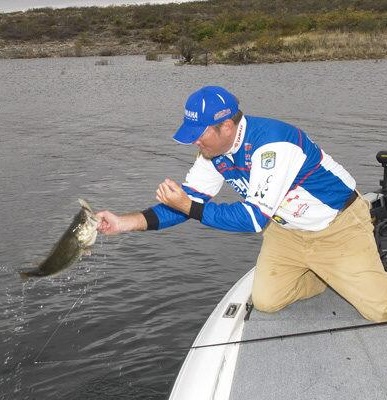 Of all the lures a bass fishermen can try when he’s fishing for cold water bass, floating jerkbaits don’t get a lot of attention. That’s fine, laughs Yamaha Pro Clark Reehm, who uses them all winter.
Of all the lures a bass fishermen can try when he’s fishing for cold water bass, floating jerkbaits don’t get a lot of attention. That’s fine, laughs Yamaha Pro Clark Reehm, who uses them all winter.
“Floating jerkbaits bring the best results when you use them around and over submerged vegetation, stumps, cypress trees, or brush in shallow water,” acknowledges Reehm, “so perhaps that’s why many anglers don’t use them. Fishermen normally move to deep water in winter, but remember, it’s the cover, and particularly vegetation, that keeps bass shallow on many lakes and rivers.
“A floating jerkbait has an added advantage over normal crankbaits because it rarely gets snagged. Whenever you feel the lure hit cover or grass, you can stop reeling and it will float to the surface.”
Jerkbaits are available in a wide variety of sizes and models by numerous manufacturers. They’re characterized by a long, narrow cigar-like body profile, and are normally fished by jerking or twitching the rod, which causes them to dart erratically side to side. Floating and sinking jerkbaits are offered, as well as models that dive to different depths.
“My favorite depth to use a jerkbait this time of year is down to about five feet,” says Reehm,” and if I can find old lily pad stems or hydrilla at that depth, I’ll work the water thoroughly with different retrieves because bass will come up out of the vegetation to hit these lures. The outside edges of vegetation and brush lines are also excellent places to try.”
The Yamaha Pro’s two favorite retrieves are either a jerk-jerk-pause, during which the lure floats to the surface during the pause; or a constant jerking and reeling retrieve that keeps the lure darting just under the surface. Reehm believes bass hit the lure because these retrieves trigger both feeding and reaction strikes.
“A floating jerkbait works anywhere you can find shallow vegetation,” he continues, “and you can fish it throughout the winter and early spring months. If you need to, you can slow down your retrieve and make your pauses longer because the lure won’t sink if you stop reeling, or you can speed up your retrieve but still keep the lure running shallow.”
Reehm keeps his color choices simple, too. He prefers a gold body/black back model on overcast days, and a chrome/black back lure on clear days. Because he’s fishing shallow water, he also prefers either heavy monofilament line or braid, neither of which sinks, as does fluorocarbon.
“Using floating jerkbaits this time of year does not get much attention because it seems to go totally against the norm,” the Yamaha Pro concludes, “but I’ve fished this technique long enough, and with enough success, for it to become one of my favorite cold water presentations.
“I keep several of the lures tied on my rods the entire winter.”
